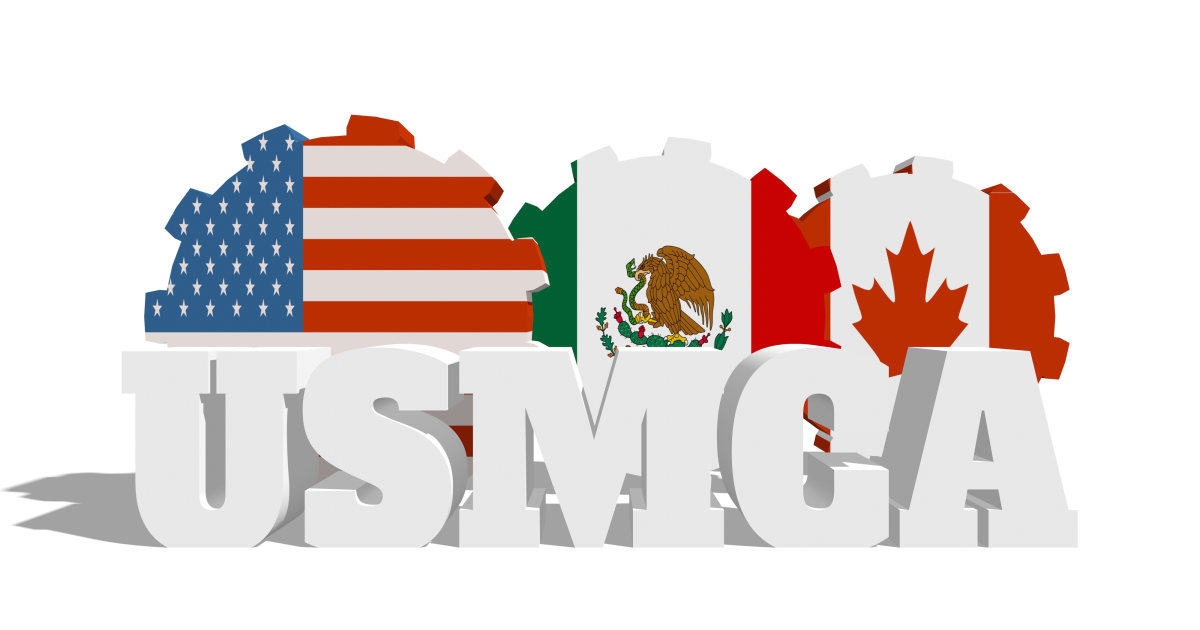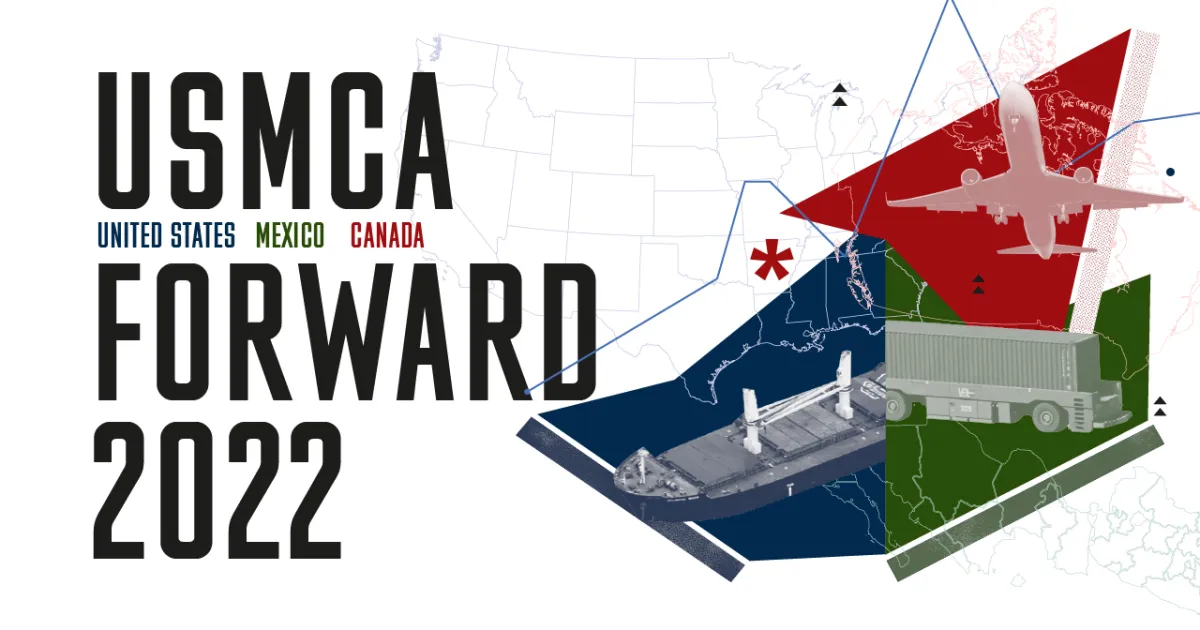
INTRODUCTION
USMCA FORWARD 2023
Letter from the editors
We are very pleased to launch our USMCA initiative’s second flagship report USMCA Forward 2023: Building more integrated, resilient, and secure supply chains. This report includes contributions from experts from the U.S., Canada, and Mexico as well as shorter viewpoints from senior government officials and leaders from industry, civil society and academia. The focus of this year’s report on supply chains reflects the opportunity presented by the significant investments that the U.S. in particular is making in developing semiconductors, electric vehicles, critical material, and clean energy. The USMCA underpins North American trade and investment and provides the set of rules and market access commitments that level set business expectations. In turn, it lays the foundation for expanding investment into complex and capital-intensive manufacturing and supply chains across North America. In addition, the agreement’s schedule of meetings including ones between the three trade ministers provide the basis for deepening the trilateral cooperation. It is clear that additional investments and policies are needed if the the vision of building more integrated, resilient, and secure North American supply chains is to be realized. USMCA has an important role to play in this respect, including in areas such as enabling worker education and training, ensuring access to the business services needed for new complex supply chains, providing a stable regulatory environment for cross-border data flows and access to digital technologies, and aligning non-tariff barriers. Finally, but not least, the USMCA labor chapter should be understood as a key pillar in building more resilient and efficient supply chains. This report addresses these issues, including the opportunities presented by USMCA, and what more is needed from the three governments.
Early in his Presidency, President Biden initiated a review of the resiliency of critical supply chains in semiconductors, large capacity batteries, critical minerals, and pharmaceuticals.1 As Canadian Minister Champagne outlines in his contribution to this report, Canada is taking a number of steps to strengthen North American supply chains. This includes investing in critical minerals under the government’s Critical Minerals Strategy, strengthening domestic R&D, and expanding manufacturing capacity in support of semiconductor development in North America. At the North American Leaders Summit in January 2023, the three North American leaders also agreed to cooperate on a range of supply chain-related initiatives around semiconductors and critical minerals.
The current focus on supply chains in North America has been driven by three related developments. First is the view of China as a strategic competitor and the risks of relying on China as a source of supply. China’s willingness to restrict trade to pressure governments on a range of non-trade-related issues has highlighted how North America’s trade dependence on China exposes each country to coercion. From this perspective, strengthening North American supply chains is a national security goal. Second, the COVID-19 pandemic exposed the fragility of global supply chains where a priority by businesses on efficiency, just in time manufacturing, and low inventories made supply chains vulnerable to disruption. Third, job losses in manufacturing have led to a focus on reinvigorating manufacturing and expanding North American supply chains as drivers of scale, efficiency, and competitiveness.
Last year saw significant U.S. legislation that includes tax incentives and subsidies for manufacturing and supply chains. For instance, the Inflation Reduction Act (IRA) includes nearly $400 billion in federal funding for clean energy with special tax credits for EVs manufactured in the region. The Infrastructure Investment and Jobs Act (IIJA) includes $1.2 trillion that will increase the overall efficiency and competitiveness of the U.S. The CHIPS and Science Act includes over $50 billion in funding for domestic semiconductor manufacturing.
These developments create a defining opportunity to expand North American manufacturing capacity, strengthen supply chain integration, and increase overall competitiveness. However, to realize this opportunity will require leaning into the many ways that USMCA supports North American trade and investment, as well as building closer forms of international cooperation and coordination. Indeed, it is the agreement’s rules, market access, and dispute settlement system that provides the foundation for developing an increasingly integrated, complex vision of how North America might cooperate and work together. In addition, a range of complementary policies and investments will be required to fully realize these opportunities. Liz Shuler, President of the AFL-CIO makes a similar point, underscoring how USMCA—along with complementary trade and domestic manufacturing policy—is a chance to take full advantage of the opportunities presented by the USMCA, IIJA, IRA, and CHIPS Act to generate jobs and improve working conditions in North America. Lance Frtiz, CEO of Union Pacific, also notes the need to build on USMCA in order to maximize these supply chain opportunities.
This report identifies how USMCA can support the trilateral goal of more integrated, resilient, and secure supply chains, and the complementary policies needed to achieve this goal. Given the complexity of the opportunities and challenges, the contributions to this report from senior government officials, business leaders, civil society, and academia identify important issues that need to be resolved. They also provide policy recommendations.
Reshoring supply chains and the national security imperative
The investments into reshoring supply chains into North America aim to grow manufacturing jobs and reduce dependence on China for the inputs and products deemed critical to U.S. economic security. Brad Martin’s contribution analyzes the complex ways that economic engagement with China raises national security risks. As Martin notes, economic interdependence—rather than pacifying international relations—has become a source of geopolitical tension as countries have sought to weaponize the reliance this interdependence creates to achieve other policies. Part of the challenge as Martin sees it is the disconnect between company-level incentives to maximize efficiency, which drives investing in China-centered supply chains, and the broader national vulnerabilities these private investment decisions can create but which are often not taken into account by the firms making the investments. In addition, Martin sees the U.S.-China geopolitical tension including with respect to Taiwan as increasing risk for North America due to the concentration of supplies of semiconductor manufacturing in Taiwan. This underscores how the intersection between economic interdependence and U.S.-China geopolitical tensions are not confined to bilateral trade relations but extend more broadly to third countries that are part of the larger Chinese supply chain ecosystem. According to Martin, USMCA has an important role to play in assessing and addressing these national security risks by creating a common understanding among the three countries of their vulnerabilities, supporting the location of critical supply chains to North America, and demonstrating how interdependence through trade and supply chains can work among trusted partners.
The North American alignment on economic and security goals also raises complex questions about the nature of trade between North America and the rest of the world—in particular China— going forward. David Dollar in his chapter makes clear that Mexico cannot replace supply chains located in China and Southeast Asia. For instance, China alone produces 20 times manufacturing value add than Mexico. Seeking to displace all the manufacturing and supply chain links would be costly and likely fail. Dollar argues that North America should instead identify the products that need to be reshored for national security goals, such as semiconductors, electric vehicles, and components including batteries and critical mineral inputs. Yet, as he observes, China and other countries in Southeast Asia are important suppliers of intermediate products that support North American Supply chains. This fact demands a North American trade strategy for Asia that ensures access to the inputs needed to maintain the competitiveness of North American supply chains.
Complementary policies support North American supply chains
A common theme across the contributions is that while the abovementioned U.S. legislation provides the necessary starting point for reshoring critical supply chains, more will be needed. In particular, if Mexico is to attract additional investment, it will need to improve its business climate, infrastructure, and connectivity, which currently lags well behind China as well as peer economies in Southeast Asia. USMCA has an important role to play in strengthening Mexico’s attractiveness as an investment destination. Compliance with USMCA commitments reduces business risk, and open markets with predictable rules support investment and trade.
One of the challenges that needs to be addressed to expand manufacturing capacity and North American supply chains is access to skilled labor. In particular, significant improvements in Mexico’s education system and training opportunities are required. Sylvia Ortega in her chapter provides a comprehensive look at the state of Mexico’s education system and where it lags behind the U.S. and Canada as well as other peers in Southeast Asia. She notes that “increasing the competitiveness in Mexico depends largely on the development of its human capital nationwide.” Sylvia outlines successful areas of trilateral cooperation on education and worker training under the North American Free Trade Agreement (NAFTA) and emphasizes the need to scale and update cooperation given the growing demand for educated Mexican workers to support North American supply chains. Sylvia suggests innovative models for training Mexican workers, such as dual education that connects workers and businesses, as well as apprenticeship models. Recent discussions at the North American Leaders’ Summit that connect development of semiconductor supply chains with worker training needs are examples of how enhanced cooperation across government, industry, and civil society can deliver the workforce needed to realize these supply chain ambitions.
J. Bradford Jensen also underscores education as a precursor to delivering the business services needed for sophisticated supply chains. He observes that services inputs–whether domestic or imported– account for about 27 percent of the value of manufacturing exports in many countries, and this rises to 53 percent when accounting for services provided within manufacturing firms. Jensen notes that Mexico lacks the business services needed for sophisticated supply chains, which reflects a shortage of educated workers. He concludes that this will require increased business services imports to Mexico from the U.S. and Canada, and in the longer term, he points to the key need to improve educational attainment and training opportunities.
Addressing non-tariff measures (NTMs) is another complementary policy needed to support expanding and deepening supply chains across North America. Duplicate testing and certification requirements before goods can be used in North American supply chains create unnecessary costs and delays. Beatriz Leycegui outlines NTMs of concern as well as progress under NAFTA addressing NTMs. Importantly, USMCA includes even more robust commitments to address NTMs. Progress aligning technical regulations and standards as well as mutual recognition that cover new supply chains such as in batteries, EV components, and semiconductors will be needed to minimize unnecessary costs and enable competitive supply chains. Leycegui recommends government and industry prioritize these issues.
Data flows across North America and its regulation is another area where USMCA provides an important framework and where further work is needed in the context of strengthening North America supply chains. Indeed, Dan Ciuriak makes the key point that USMCA creates a stable policy framework that should make North America an increasingly attractive investment destination for digital technologies, many of which will be needed in realizing growth in manufacturing and supply chains. This point underscores more broadly the multidimensional ways that USMCA can reduce risk and policy uncertainty and improve the investment environment in all countries.
Another related complementary policy issue raised in this report is access to clean energy as a crucial input into North American supply chains. Indeed, Valeria Moy notes that this will also be important to realize the digital economy opportunities that Dan Ciuriak describes given its energy intensity. More broadly, both Valeria Moy and Lourdes Melgar make clear the need for Mexico to follow the U.S. and Canadian investments in renewable energy. They also underscore the need to better integrate the North American energy market to increase energy security and deliver on renewable energy.
International labor standards and human rights in supply chains
Another theme in this report is the importance of compliance with labor standards and international human rights in supply chains as key elements of more secure and resilient supply chains. Kevin Kolben in his contribution makes the case that “there is a strong argument that FTA labor chapters should be viewed positively as a tool to mitigate supply chain risk and increase resilience.” He argues that business labor practices consistent with ILO standards are more efficient and resilient. From this perspective, the USMCA labor chapter and its rapid response mechanism should be seen as tools in building more efficient and resilient North American supply chains. This can happen in a number of ways, including reducing strikes that affect supply chain resiliency and increasing political and consumer support for USMCA when goods are produced consistently with international labor standards. Kolben notes that UMSCA also bans importing goods made with forced labor, and the second USMCA Free Trade Commission meeting in July 2022 reaffirmed this commitment. This is a point that Jennifer Gordon also highlights and shines the spotlight on labor practices in the U.S. as they apply to migrant workers in the agricultural sector.
A joint contribution by Alan Bersin and Thomas Ewing sheds additional light on the extent that North American supply chains continue to use inputs that are made with forced labor. The authors note the challenge of getting visibility into supply chains to understand where products with forced labor may be entering. They discuss how federated learning can use data consistently with privacy and security standards to map supply chain participation globally. For instance, this technology, the authors find, has helped to identify goods produced from Uyghur forced labor that continue to enter North American supply chains including in industries such as medical devices, wholesale chemical products, and food manufacturing.
Cooperation and enforcement
The need to expand trilateral cooperation among government, business, and civil society in the three countries is a point made repeatedly by many of the leaders from government and industry. The North American Leaders’ Summit has the potential to drive a lot of the cooperative work needed to realize these supply chains ambitions. Indeed, Senator Ruiz Massieu notes the establishment of a trilateral semiconductor forum at the summit as an important development that will help address policy and investment needs. Also, there is the annual USMCA Free Trade Commission (FTC) meeting in addition to the regular work of the USMCA committees. Lance Fritz of the U.S. Business Roundtable highlights the need for a USMCA FTC mechanism to ensure trade continues during public emergencies.
Moreover, North American governments have revised bilateral and industry focused dialogues in response to the renewed focus on economic integration and resilient supply chains in North America. This includes the Canada-U.S. Supply Chain Working Group, U.S.-Mexico High Level Economic Dialogue, and Canada-Mexico High Level Economic Dialogue launched in 2022.
Finally but not least, many contributors emphasize that compliance with USMCA by all governments is crucial for it to serve as a framework for increased investment and cooperation. As Jay Timmons stated succinctly, “Trade agreements are only as good as their enforcement.” Thus, the utilization of the USMCA labor chapter rapid response mechanism by the U.S. and reliance on the state-state dispute settlement mechanism to resolve disputes by all governments should be viewed as positive developments. This will be monitored through the USMCA Tracker and Scorecard that we have developed as part of the USMCA initiative. The use of the USMCA dispute settlement mechanisms demonstrates that trade disputes can be resolved through arbitration and, more broadly, shows a commitment to the agreement and the rule of law, which boosts confidence in USMCA overall.
The range of policy recommendations in this report outlines the investments and policies that are needed to maximize the opportunities presented to grow North American trade that already supports over 9.5 million jobs region-wide (latest estimates from the Brookings’s USMCA Tracker). As made clear in this report, USMCA is central to this agenda. However, this report also speaks to the complementary policies needed in all three countries—together with the USMCA—that will help North America build the more integrated, resilient, and secure supply chains that it needs.
Endnotes
- 1. The White House, Building Resilient Supply Chains, Revitalizing American Manufacturing, And Fostering Broad-Based Growth”, 100-Day Reviews under Executive Order 14017, June 2021 100-day-supply-chain-review-report.pdf (whitehouse.gov)
Viewpoints

François-Philippe Champagne explains how Canada can help strengthen North America’s supply chain resiliency and industry competitiveness.

Claudia Ruiz Massieu takes stock of the USMCA, detailing the challenges and opportunities in the year ahead.

